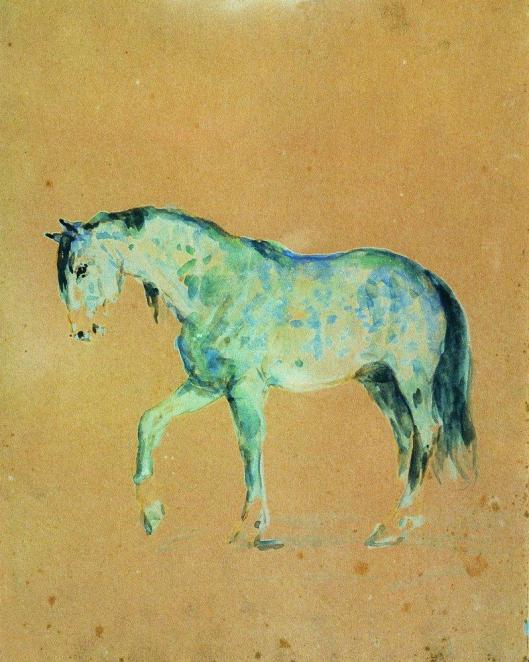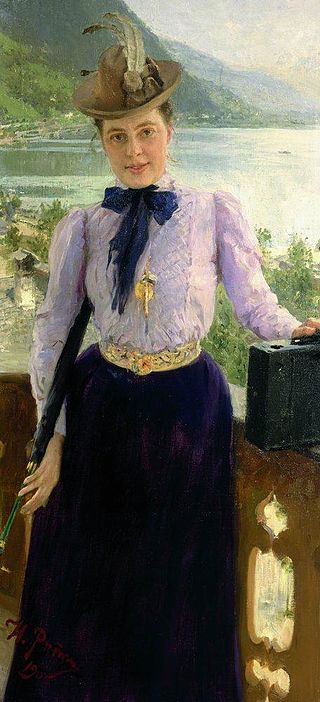Tags
Album of Natalia Nordman-Severova, Balalaika, Burlak, Feodor Chaliapin, Ivan Kramskoi, Modest Mussorgsky, Natalia Nordman, Realism, Repin's horse, Song of the Volga Boatmen, The Penates, Wednesday at Penaty

Horse by Ilya Repin (Wikiart.org.)
Repin’s Horse
The horse featured above is an artwork by one of Russia’s foremost portraitists, Ilya Repin (5 August [O.S. 24 July] 1844 – 29 September 1930). No date is given and I haven’t found a signature. We do not know when Horse was completed. Nor do we know whether Repin wanted this work to be shown.
It is lovely, but it differs from other paintings by Repin. To my knowledge, the colour indigo was not used to depict horses in 19th-century Russia. Nor were blues, greens, and turquoise, a mixture. The background, sand with a golden hue, is almost traditional. It could be used as the background to a portrait. However, in Horse, the background is primarily flat. Moreover, were it not for a larger number of gold-coloured speckles in the sand, in the lower part of the painting, Repin would not have ‘sat’ his horse. You may have noticed also that Repin’s horse does not cast a shadow and that its snout as well as its lower legs are ‘interrupted.’ We are therefore reminded of Japonism and childhood. Horse is classified as a realist work of art. It is a realist work of art in as much as we know the figure it portrays is a horse, but the horse is of a different colour.
“A Moral Social Purpose”
In 1878, Repin joined the Society of the Peredvizhniki or Itinerant’s Society, which can be traced back to the “Rebellion of the Fourteen,” when 14 young artists left the school after refusing to paint mythological paintings for their diplomas. “In 1891 he resigned from the Itinerants’ Society in protest against a new statute that restricted the rights of young artists.” (See Ilya Repin, Wiki2.org. & Ilya Repin, Wikiart.org.)
However, Repin was not a rebel. By and large, he followed in the footsteps of his teacher, Ivan Kramskoi. He may have been influenced by Ivan Bunakov, with whom Repin’s father helped him apprentice. With Bunakov, a local icon painter, “he restored old icons and painted portraits of local notables through commissions.” (See Wiki2.org.) However, although he was familiar with impressionism, and “admired some impressionist techniques, especially their depictions of light and color, he felt their work lacked moral social purpose, key factors in his own art.”
A Portrait Artist
“Repin had a set of favorite subjects, and a limited circle of people whose portraits he painted. But he had a deep sense of purpose in his aesthetics, and had the great artistic gift to sense the spirit of the age and its reflection in the lives and characters of individuals.”
(See Ilya Repin, Wiki2.org.)
Repin was a portraitist, though not exclusively. Philanthropist and art lover and collector Pavel Tretyakov, a patron of Repin, expressed a need for depictions of his contemporaries. Repin’s portrait of composer Modest Mussorgsky (21 March 1839 – [16 O.S..] 28 March 1881), one of the Five, is unforgettable. It was painted shortly before the composer’s death. Mussorgsky’s family lost half of its estate in 1861, the year serfs were emancipated, which precipitated a crisis. Mussorgsky also joined a group indulging in an “intense worship of Bacchus.” (See Modest Mussorgsky, Wiki2. org.). Alcoholism destroyed him. This portrait suggests compassion on the part of Repin.

Ilya Repin‘s celebrated portrait of Mussorgsky, painted 2–5 March 1881, only a few days before the composer’s death (Wiki2.org.)
The Common People
Repin’s “paintings show his feeling of personal responsibility for the hard life of the common people and the destiny of Russia.” (See Ilya Repin, Wiki2.org.)
Repin’s Barge Haulers on the Volga may well be his most famous comment on the life of “the common people.” The barge haulers were called burlaks and attracted Repin’s attention between 1870 and 1873. They resembled convicted men condemned to row galleys.
The industrial revolution may have liberated the barge haulers, but if it did, liberation was probably achieved in the manner serfs were emancipated. Many former serfs had to pay for the land they had tilled and had fed them. Former serfs were also employed in factories where they worked 15 hours a day, which I suspect was the fate of burlaks. (See Bloody Sunday, Wiki2.org.)

Barge haulers on the Volga by Ilya Repin, 1873 (Russian Museum and Wikiart.org)

Burlak by Ilya Repin, 1870-1873 (WikiArt.org.)
1902 Song of the Volga Boatmen record by Feodor Chaliapin ✔
The Penates, Finland
In 1872, Repin married Vera Shevtsova. His marriage lasted ten years. Natalia Nordman (14 December 1863 – 30 June 1914) was “the love of Repin’s life.” (See WikiArt.org.) They lived in her house, called Penaty (the Penates), in Kuokkala, Finland. According to Wikiart.org., Repin designed and built the Penates (See Wikiart.org.). I am therefore confused. However, the common denominator is that Ilya Repin and Natalia Nordman-Severova lived at the Penates. On Wednesday, the couple received guests. Repin made sketches of their guests and Natalia Nordman was the keeper of the album. The Album is entitled Portrait from the Album of Natalia Nordman-Severova.

The Penates, the Repin House-Museum in Kuokkala, now Repino, Saint Petersburg (Wiki2.org.)
Conclusion
Repin chronicled a golden age: Alexander Pushkin, Fyodor Dostoyevsky, Leo Tolstoy, the Five, Ilya Repin, Isaac Levitan, Alexei Savrasov. Yet it was a bleak world. Russia was at a turning-point. Peasants had lived in communes, the Mir, but the industrial age would impair the Emancipation of Serfdom, 1861. As noted, several former serfs worked in factories, where working conditions were unacceptable. Building a railroad could be the source of enormous wealth for Russians who had money to invest, but did former serfs have money?
So Horse makes sense. It is fanciful, but not too fanciful. In fact, it is little more than, as noted above, a horse of a different colour. However, horses of a different colour may constitute not a new, but a gentler reality.
RELATED ARTICLES
- Mussorgsky’s Old Castle (17 November 2018)
- Mussorgsky & Repin: a new Dawn (10 November 2018)
Sources and Ressources
- Ilya Efimovich Repin (a collection of paintings)
- Balalaika (Wiki2.org.) (description)
Love to everyone 💕

© Micheline Walker
2 February 2019
WordPress


The horse is beautiful. Repin seems to have had great compassion for nature and humanity.
LikeLiked by 1 person
Compassion and innocence is what I captured in “Horse.” And “Horse” is beautiful. I’m happy that it survived. I believe Repin was a very good person. Thank you Amanda. 🙂
LikeLiked by 1 person
An excellent conclusion
LikeLiked by 1 person
Artists, writers, composers could do very little to help the poor, but they kept a testimonial and “Horse” offered a glimpse of a slightly better world. I’m glad Repin could live in Finland after he met Natalia (1900). Penaty was 30 kilometers away from Saint Petersburgh, but they were in Finland, which was a better world. 🙂
LikeLiked by 1 person
We studied it as kids in the Russia scrupulously in middle school and had to ride a huge composition on every character- very deep scene with exposure to humanity
LikeLiked by 1 person
Russia is a lesson on charity, love, devotion: humanity. There were bad times, but compassion and spirituality remained. I thank you for writing. Micheline
LikeLiked by 1 person
I love art.. such a wonderful selection of paintings. My favorite one is: “Barge haulers on the Volga by Ilya Repin, 1873” – “Бурлаки на Волге”, amazing painting. There is also a song Russian MMA fighter Fedor Emelyanko, asks to play before each fight – this song is about Barge haulers on the Volga by Ilya Repin.
LikeLiked by 1 person
The Barge Haulers are a symbol of humankind’s plight. These men worked like beasts of burden and I pity beasts of burden. How could they make sense of life. I think the song helped men and that they helped one another if they had time to speak to one another. Repin had the courage of recording their misery. I’m sure the song and Repin’s are examples of the spirituality of Russia’s spiritually repertoire. I thank you for mentioning Fedor Emelyanko and for writing. Best regards.
LikeLiked by 1 person